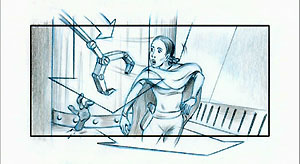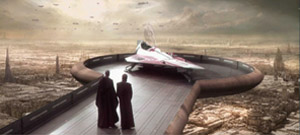 |
STAR
WARS – EPISODE II – ATTACK OF THE CLONES
Director: George
Lucas
Starring: Ewan
McGregor, Samuel L. Jackson, Natalie Portman
WARNING: This article contains spoilers! DISC TWOThere’s a fine balance to be struck when preparing supplemental bonus materials for a DVD (especially when, as here, so much is being offered). Fans, of course, want to see absolutely everything. More casual viewers might only want to spend an hour or two watching the extra footage. There’s a wealth of material on this disc, almost enough to please everyone, and certainly more than enough for less dedicated viewers. There are two documentaries that form the core of the disc. They’re much more focused on specific aspects of the production process than The Beginning (the hour-long documentary on Episode I disc) and complement what was on The Phantom Menace disc very nicely. From Puppets to Pixels –
Digital Characters in Episode II
[52’17”]
The documentary examines the creation and evolution of
several key characters, including café owner Dexter Jettster, but focuses
on the task of turning Yoda from an “874-year old frog” to an
ass-kicking martial arts master, for his duel at the climax of the movie.
The documentary puts the animators in the spotlight: as Lucas wryly notes,
digital actors will never replace real actors, at least not while real
animators are needed instead! The documentary never gets too technical
(although some basic knowledge of the techniques involved will help
viewers appreciate what’s happening on many of the close-ups of computer
monitors that are featured), and there’s time for some levity, too
(including a nice moment where veteran Hammer star Christopher Lee is
confronted with a Yoda stand-in with vampire fangs! State of the Art – The Pre-Visualisation
of Episode II [23’25”]
Deleted Scenes There are seven entirely new deleted scenes, and one
that’s an extension of an existing scene. These can be played with or
without introductions from Lucas, Ben Burtt and Rick McCallum, explaining
their context and the reason why they were ultimately dropped.
There are references all over the disc to deleted scenes that haven’t
been included, (including a shot of the “naked” C-3PO on location in
Tunisia, where Anthony Daniels spent “days” shooting it, apparently).
It’s obviously Lucasfilm’s intention is that people will only get to
see deleted scenes when they’ve been fully completed to the same high
standard as the rest of the film, which is obviously an enormously
expensive process, and very time consuming. I’m sure fans of the series
would have been ecstatic to see unfinished versions of some of the
still-missing scenes, but they'll have to settle for what's here! The scenes included on the disc are:
This scene was intended to be included near the beginning of the film, shortly after the first assassination attempt on her life. In it Amidala pleas with the Galactic Senate for peace, as the consensus of opinion shifts towards Palpatine’s “New Order” option: war. Lucas dropped the scene, choosing to personalise the threat to his lead characters, rather than overtly politicise the situation.
Obi-Wan Kenobi visits the Jedi archives, where two floating analysis druids attempt to trace the source of the only clue to the identity of Zam Wesell’s killer, the poison-tipped sabredart. The scene was dropped because it was a transitory scene that didn’t add anything to the plot: at the end of the scene neither Obi-Wan nor the audience was any the wiser.
A good example of Lucas’ masterful use of virtual sets, this scene, in which Obi-Wan expresses his concerns about Anakin’s suitability as Amidala’s bodyguard, and his development as a Jedi Knight, was re-written, moved to a different location (the Jedi temple, which allowed Lucas to add Yoda to the scene), and shuffled to a spot earlier in the film. As a nice continuity point, the scene ends with Obi-Wan leaving in the Jedi starfighter that we see him in when he arrives at Geonosis.
This is a longer version of the scene where Anakin and Amidala arrive at the Naboo capital. In this longer version the trio cross the square, discussing Amidala’s first visit to the capital, and how her parents were concerned for her safety while she was Queen.
A scene that Lucas admits was “very difficult to cut out”, this is a very nice sequence: Padmé visits her parents and sister with “bodyguard” Anakin (wink wink) in tow. It’s a shame this was dropped since it’s a situation that will be very familiar to many young couples, and would have been a rather pivotal point in their blossoming relationship, (despite Padmé claims their relationship is “strictly professional”).
An
extension of the Padmé’s
Parents’ House sequence,
this is a little pointless. The main purpose it serves is to further
expand on Padmé’s
back-story, using a series of holographic animated pictures hanging on the
walls. For some reason, it’s also yet another scene of Amidala packing a
suitcase! When Padmé’s
Parents’ House was
ultimately deemed disposable, it was inevitable that linked scene would
also hit the cutting room floor.
Following their capture by Boba Fett and the Geonosis factory workers, Padmé and Anakin are brought before the enigmatic Count Dooku, who offers to release Obi-Wan in return for Amidala surrendering Naboo to his alliance (“The Republic cannot be fixed… it’s time to start over…”) This scene was dropped because Lucas felt that the focus had moved away from Obi-Wan for too long, and ultimately chose to replace it with the scene of Dooku offering a similar deal to Obi-Wan.
Considerably
less interesting that it sounds (especially if the title brings memories
of the Klingon trial in Star Trek VI: The Undiscovered Country to
mind), this short scene is a continuation of Dooku Interrogates Padmé.
Anakin and Padmé
are sentenced on espionage charges, and sent to appear in the arena. This
scene was dropped partly because it made it obvious too early that Count
Dooku was a villain, but mainly as a consequence of the interrogation
scene being dropped. MORE: PAGE THREE |


 This
documentary begins with footage from behind the scenes of the original
trilogy, showing how creatures like Jabba the Hutt and Yoda were created
using puppets or full-size props. That’s how it used to be done. Lucas
has revolutionised the industry over the last decade or so, advancing the
art of special effects to the point where now virtually anything that can
be imagined can be put on the screen. Huge chunks of Episode II were
shot using, or augmented with, computer generated backgrounds, creatures
and characters. The film’s commentary track is very revealing: it often points
out which elements of a shot were real, and which were created
electronically. Sometimes this is all too obvious, but the extent that
these techniques were used in the film will come as a shock to many
viewers. For example, even though the clone troopers feature in
numerous scenes, in shots that vary from close-ups with dialogue to long
shots with hundreds (if not thousands) of them on screen at once, the
filmmakers never made a single clone trooper costume: in every shot
they’re CGI characters.
This
documentary begins with footage from behind the scenes of the original
trilogy, showing how creatures like Jabba the Hutt and Yoda were created
using puppets or full-size props. That’s how it used to be done. Lucas
has revolutionised the industry over the last decade or so, advancing the
art of special effects to the point where now virtually anything that can
be imagined can be put on the screen. Huge chunks of Episode II were
shot using, or augmented with, computer generated backgrounds, creatures
and characters. The film’s commentary track is very revealing: it often points
out which elements of a shot were real, and which were created
electronically. Sometimes this is all too obvious, but the extent that
these techniques were used in the film will come as a shock to many
viewers. For example, even though the clone troopers feature in
numerous scenes, in shots that vary from close-ups with dialogue to long
shots with hundreds (if not thousands) of them on screen at once, the
filmmakers never made a single clone trooper costume: in every shot
they’re CGI characters. One
of the key advances for Attack of the Clones was a much more
extensive use of animatics (video mock-ups of action scenes, using
relatively crude computer animation, or models). These have virtually
replaced traditional storyboard techniques on hi-tech, big-budget productions like Episode
II. This documentary demonstrates how there have been huge technical advances since
animatics were used on the
original Star Wars trilogy. Viewers may well be astonished by a
sequence
showing scenes from the original Star Wars movie, side by side with
the archive war footage that inspired it – they’re virtually
identical!
One
of the key advances for Attack of the Clones was a much more
extensive use of animatics (video mock-ups of action scenes, using
relatively crude computer animation, or models). These have virtually
replaced traditional storyboard techniques on hi-tech, big-budget productions like Episode
II. This documentary demonstrates how there have been huge technical advances since
animatics were used on the
original Star Wars trilogy. Viewers may well be astonished by a
sequence
showing scenes from the original Star Wars movie, side by side with
the archive war footage that inspired it – they’re virtually
identical!  Lucas explains that many sequences are now
very closely
modelled on the animatics, allowing him and his editors to prepare a rough
cut of any given sequence, even allowing Lucas to determine exactly how
long each shot needs to be (a valuable piece of knowledge, when every
second of computer animation may cost thousands of dollars). Three key
sequences are featured here: the Speeder Chase (Obi-Wan chasing Zam Wesell
through the skyscrapers on Coruscant), Droid Factory (the conveyor belt
scene) and the Clone War finale. The use of animatics also gives the
actors something to look at when they’re being shot in blue-screen sets.
Lucas is rapidly evolving a new way of filmmaking, by shooting tiny
elements of shots that will be composited together later. The documentary
wraps with a few goofy shots woven into the end credits (similar to those
gleefully included on the Shrek and Toy Story discs).
Lucas explains that many sequences are now
very closely
modelled on the animatics, allowing him and his editors to prepare a rough
cut of any given sequence, even allowing Lucas to determine exactly how
long each shot needs to be (a valuable piece of knowledge, when every
second of computer animation may cost thousands of dollars). Three key
sequences are featured here: the Speeder Chase (Obi-Wan chasing Zam Wesell
through the skyscrapers on Coruscant), Droid Factory (the conveyor belt
scene) and the Clone War finale. The use of animatics also gives the
actors something to look at when they’re being shot in blue-screen sets.
Lucas is rapidly evolving a new way of filmmaking, by shooting tiny
elements of shots that will be composited together later. The documentary
wraps with a few goofy shots woven into the end credits (similar to those
gleefully included on the Shrek and Toy Story discs).  Padm
Padm Jedi Temple Analysis Room
Jedi Temple Analysis Room Obi-Wan and Mace – Jedi
Landing Platform
Obi-Wan and Mace – Jedi
Landing Platform Extended Arrival on Naboo
Extended Arrival on Naboo
 Padmé’s Bedroom
Padmé’s Bedroom
